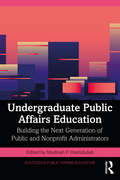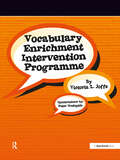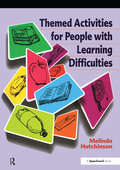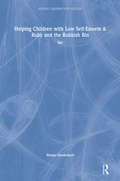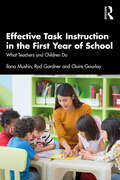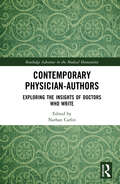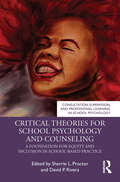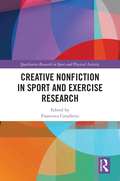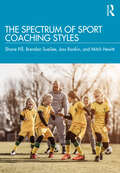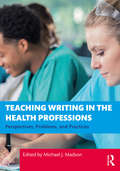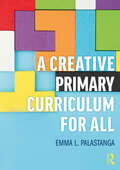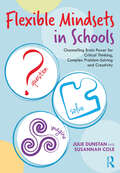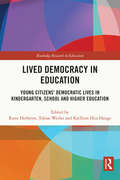- Table View
- List View
Undergraduate Public Affairs Education: Building the Next Generation of Public and Nonprofit Administrators (Routledge Public Affairs Education)
by Madinah F. HamidullahPublic affairs and nonprofit program administrators and directors interested in (or tasked with) implementing undergraduate programs require a resource where they can find information for recruiting and retaining the next wave of public and nonprofit workers. While similar to graduate public affairs programs, undergraduate programs may differ in curriculum design, recruitment targets, learning outcomes, and community engagement opportunities. Universities may have different motivations in creating an undergraduate program, from a need to generate additional resources, a clearer pathway to master’s education, or offering complete degrees in themselves that prepare students for employment in the public or nonprofit sector. This book is the first of its kind to offer concrete, experienced guidance, tips, and general best practices in public affairs and nonprofit undergraduate education from those who have "been there", with chapters written by current and former program administrators and directors. Exploring the variety of programs that are offered in public and nonprofit affairs/administration, the different degree components and specializations, types of experiential learning, different assessment and outcome practices, the value of accelerated degree programs, the current place of accreditation, and the appropriate resources available for program directors and administrators, this book will be of interest to faculty and advanced graduate students that will be teaching/developing curruicula in public and nonprofit degree programs that have undergraduate students.
Undergraduate Public Affairs Education: Building the Next Generation of Public and Nonprofit Administrators (Routledge Public Affairs Education)
by Madinah F. HamidullahPublic affairs and nonprofit program administrators and directors interested in (or tasked with) implementing undergraduate programs require a resource where they can find information for recruiting and retaining the next wave of public and nonprofit workers. While similar to graduate public affairs programs, undergraduate programs may differ in curriculum design, recruitment targets, learning outcomes, and community engagement opportunities. Universities may have different motivations in creating an undergraduate program, from a need to generate additional resources, a clearer pathway to master’s education, or offering complete degrees in themselves that prepare students for employment in the public or nonprofit sector. This book is the first of its kind to offer concrete, experienced guidance, tips, and general best practices in public affairs and nonprofit undergraduate education from those who have "been there", with chapters written by current and former program administrators and directors. Exploring the variety of programs that are offered in public and nonprofit affairs/administration, the different degree components and specializations, types of experiential learning, different assessment and outcome practices, the value of accelerated degree programs, the current place of accreditation, and the appropriate resources available for program directors and administrators, this book will be of interest to faculty and advanced graduate students that will be teaching/developing curruicula in public and nonprofit degree programs that have undergraduate students.
Vocabulary Enrichment Programme: Enhancing the Learning of Vocabulary in Children
by Victoria JoffeThis book helps to enhance the understanding and use of vocabulary in secondary school students and young adults. Specifically designed for older children and young adults with language and communication needs, this practical language programme was created by a specialist speech & language therapist with input from secondary school teachers and students. The Vocabulary Enrichments Programme: focuses on enhancing the understanding and expression of vocabulary and word meanings in students aged from 8 to 18 aims to create an awareness of how improved vocabulary knowledge can be used to enhance learning in school and social interactions in school and home environments encourages an awareness and interest in words and language, introduces the concept of words and meanings and identifies their role and use in language, communication and social interaction introduces the word map and explore the rich networks of information attached to each word, including the meanings and make up of words using root and base words, suffixes and prefixes, synonyms and antonyms, and the etymology (origins) of words focuses on themes taken from the National Curriculum, including living and non living organisms, planet Earth and the world, the human body, emotions, healthy living, and occupations enhances the understanding and use of figurative and idiomatic language as well as more compound and complex sentence structures introduces a range of cueing techniques to aid in word retrieval. This book provide effective strategies for word learning to encourage independent word learning skills. It teaches an effective, efficient and realistic use of the dictionary as a tool for word learning and explore the role of the thesaurus in enhancing oral and written work.
Themed Activities for People with Learning Difficulties
by Melinda HutchinsonUser-friendly and practical, this is an excellent resource for all professionals looking to run creative sessions with people with profound and complex learning difficulties. Using a selection of twenty everyday objects, it provides resource materials, ideas and flexible structures to extend and complement professionals' existing approaches. It examines a range of teaching approaches, ideas for adapting activities and equipment, and how to present materials and tasks to the student while providing ideas, work outlines, activities and methods, recording sheets and photocopiable materials. It can be used with individuals and groups in a variety of settings, including educational establishments, day provisions or at home and is designed to provide opportunities for participation at all ability levels. With the help of this book, the list of object-based activities is endless!
Helping Children with Low Self-Esteem & Ruby and the Rubbish Bin: Set (Helping Children with Feelings)
by Margot SunderlandThis practical guidebook, with a beautifully-illustrated storybook, enables teachers, parents and professionals to help children aged 4-12 connect with unresolved feelings affecting their behaviour. Helping Children with Low Self-Esteem is a guidebook to help children who: don't like themselves or feel there is something fundamentally wrong with them have been deeply shamed have received too much criticism or haven't been encouraged enough let people treat them badly because they feel they don't deserve better do not accept praise or appreciation because they feel they don't deserve it feel defeated by life, fundamentally unimportant, unwanted or unlovable bully because they think they are worthless or think they are worthless because they are bullied and, feel they don't belong or do not seek friends because they think no-one would want to be their friend. Ruby and the Rubbish Bin is a story for children with low self-esteem. Ruby hates herself so much that she often feels more like a piece of rubbish than a little girl. Sometimes Ruby feels so miserable that she wants to sleep and sleep and never wake up again. Then Ruby meets Dot and, over time, Dot helps Ruby to move from self-hate to self-respect. After a very important dream, and help from Dot, Ruby finds her voice and her anger, and stands up to the bullies. She makes new friends and knows what it's like to feel happy for the first time in her life.
Vocabulary Enrichment Programme: Enhancing the Learning of Vocabulary in Children
by Victoria JoffeThis book helps to enhance the understanding and use of vocabulary in secondary school students and young adults. Specifically designed for older children and young adults with language and communication needs, this practical language programme was created by a specialist speech & language therapist with input from secondary school teachers and students. The Vocabulary Enrichments Programme: focuses on enhancing the understanding and expression of vocabulary and word meanings in students aged from 8 to 18 aims to create an awareness of how improved vocabulary knowledge can be used to enhance learning in school and social interactions in school and home environments encourages an awareness and interest in words and language, introduces the concept of words and meanings and identifies their role and use in language, communication and social interaction introduces the word map and explore the rich networks of information attached to each word, including the meanings and make up of words using root and base words, suffixes and prefixes, synonyms and antonyms, and the etymology (origins) of words focuses on themes taken from the National Curriculum, including living and non living organisms, planet Earth and the world, the human body, emotions, healthy living, and occupations enhances the understanding and use of figurative and idiomatic language as well as more compound and complex sentence structures introduces a range of cueing techniques to aid in word retrieval. This book provide effective strategies for word learning to encourage independent word learning skills. It teaches an effective, efficient and realistic use of the dictionary as a tool for word learning and explore the role of the thesaurus in enhancing oral and written work.
Themed Activities for People with Learning Difficulties
by Melinda HutchinsonUser-friendly and practical, this is an excellent resource for all professionals looking to run creative sessions with people with profound and complex learning difficulties. Using a selection of twenty everyday objects, it provides resource materials, ideas and flexible structures to extend and complement professionals' existing approaches. It examines a range of teaching approaches, ideas for adapting activities and equipment, and how to present materials and tasks to the student while providing ideas, work outlines, activities and methods, recording sheets and photocopiable materials. It can be used with individuals and groups in a variety of settings, including educational establishments, day provisions or at home and is designed to provide opportunities for participation at all ability levels. With the help of this book, the list of object-based activities is endless!
Effective Task Instruction in the First Year of School: What Teachers and Children Do
by Ilana Mushin Rod Gardner Claire GourlayIt is well recognised that classroom teaching is highly complex and that teachers must navigate and negotiate myriad interactions just within a lesson in order to manage the learning opportunities of their students. What is less well recognised is precisely how these interactions are managed in real time during actual classroom interactions. This book is designed as an original, close-up account of processes by which children learn to become school learners in their first year of school, unpacking some of the recognised complexity of busy classrooms to hone in on what teachers and children do and how learning takes place. Using the tools of conversation analysis, the authors unpack a range of pedagogical interactions between teachers and children during normal class, focusing on procedural instructions and the outcomes of instructed activities. By including transcripts of recordings of classes in schools located in diverse communities, it is possible to see which aspects of classroom interaction may be impacted by external factors, such as children’s language or cultural background, and which aspects are applicable regardless of such factors. The chapters examine teacher instructions and children’s behaviour during instructions and during task performance in whole-class and small-group interactions. Effective Task Instruction in the First Year of School brings forward a much-needed wealth of knowledge into how to teach children in the first year of schooling and beyond in a way that is accessible for practising teachers, student teachers as well as education researchers.
Effective Task Instruction in the First Year of School: What Teachers and Children Do
by Ilana Mushin Rod Gardner Claire GourlayIt is well recognised that classroom teaching is highly complex and that teachers must navigate and negotiate myriad interactions just within a lesson in order to manage the learning opportunities of their students. What is less well recognised is precisely how these interactions are managed in real time during actual classroom interactions. This book is designed as an original, close-up account of processes by which children learn to become school learners in their first year of school, unpacking some of the recognised complexity of busy classrooms to hone in on what teachers and children do and how learning takes place. Using the tools of conversation analysis, the authors unpack a range of pedagogical interactions between teachers and children during normal class, focusing on procedural instructions and the outcomes of instructed activities. By including transcripts of recordings of classes in schools located in diverse communities, it is possible to see which aspects of classroom interaction may be impacted by external factors, such as children’s language or cultural background, and which aspects are applicable regardless of such factors. The chapters examine teacher instructions and children’s behaviour during instructions and during task performance in whole-class and small-group interactions. Effective Task Instruction in the First Year of School brings forward a much-needed wealth of knowledge into how to teach children in the first year of schooling and beyond in a way that is accessible for practising teachers, student teachers as well as education researchers.
Contemporary Physician-Authors: Exploring the Insights of Doctors Who Write (Routledge Advances in the Medical Humanities)
by Nathan CarlinThis book examines the phenomenon of physician-authors. Focusing on the books that contemporary doctors write--the stories that they tell--with contributors critically engaging their work. A selection of original chapters from leading scholars in medical and health humanities analyze the literary output of doctors, including Oliver Sacks, Danielle Ofri, Atul Gawande, Louise Aronson, Siddhartha Mukherjee, and Abraham Verghese. Discussing issues of moral meaning in the works of contemporary doctor-writers, from memoir to poetry, this collection reflects some of the diversity of medicine today. A key reference for all students and scholars of medical and health humanities, the book will be especially useful for those interested in the relationship between literature and practising medicine.
Contemporary Physician-Authors: Exploring the Insights of Doctors Who Write (Routledge Advances in the Medical Humanities)
by Nathan CarlinThis book examines the phenomenon of physician-authors. Focusing on the books that contemporary doctors write--the stories that they tell--with contributors critically engaging their work. A selection of original chapters from leading scholars in medical and health humanities analyze the literary output of doctors, including Oliver Sacks, Danielle Ofri, Atul Gawande, Louise Aronson, Siddhartha Mukherjee, and Abraham Verghese. Discussing issues of moral meaning in the works of contemporary doctor-writers, from memoir to poetry, this collection reflects some of the diversity of medicine today. A key reference for all students and scholars of medical and health humanities, the book will be especially useful for those interested in the relationship between literature and practising medicine.
Critical Theories for School Psychology and Counseling: A Foundation for Equity and Inclusion in School-Based Practice (Consultation, Supervision, and Professional Learning in School Psychology Series)
by Sherrie L. Proctor David P. RiveraCritical Theories for School Psychology and Counseling introduces school psychologists and counselors to five critical theories that inform more equitable, inclusive work with marginalized and underserved student populations. Offering accessible conceptualizations of each theory and explicit links to application in practice and supervision, the book speaks to common professional functions and issues such as cognitive assessment, school-based counseling, discipline disproportionality, and more. This innovative collection offers graduate students, university faculty, and practicum and internship supervisors an insightful new direction for serving learners across diverse identities, cultures, and abilities.
Critical Theories for School Psychology and Counseling: A Foundation for Equity and Inclusion in School-Based Practice (Consultation, Supervision, and Professional Learning in School Psychology Series)
by Sherrie L. Proctor David P. RiveraCritical Theories for School Psychology and Counseling introduces school psychologists and counselors to five critical theories that inform more equitable, inclusive work with marginalized and underserved student populations. Offering accessible conceptualizations of each theory and explicit links to application in practice and supervision, the book speaks to common professional functions and issues such as cognitive assessment, school-based counseling, discipline disproportionality, and more. This innovative collection offers graduate students, university faculty, and practicum and internship supervisors an insightful new direction for serving learners across diverse identities, cultures, and abilities.
Creative Nonfiction in Sport and Exercise Research (Qualitative Research in Sport and Physical Activity)
by Francesca CavallerioAcademics around the world recognise the effectiveness of storytelling as a way to engage audiences in conversations, raising awareness of issues, and encouraging change. Stories are now seen as the best medium to convey information to diverse audiences. This book explores a novel approach to representing research findings through the adoption of creative nonfictional stories (CNF). At a time when dissemination of scientific research is constantly highlighted as a fundamental aspect for academics, CNF represents an opportunity to effectively communicate science to non-academic audiences through stories. By providing practical examples of how to transform findings into compelling stories rooted in data, following the mantra of showing rather than telling, which characterises CNF, Creative Nonfiction in Sport and Exercise Research helps researchers – qualitative, quantitative, established professors, and students – to turn their research into stories. A unique contribution to the field, this book is the first to show rather than tell – the creative nonfiction mantra – scholars how they can move from their classic realist tales to a more creative, compelling, but still rigorous representation of research findings. The book features chapters written by authors from different sport research backgrounds, who present the findings of a previously published ‘classic’ study rewritten in the form of a story. Reflective chapters focusing on the how-to and the challenges of this creative analytical practice complete the work, to support scholars in developing their creative skills.
The Spectrum of Sport Coaching Styles
by Shane Pill Brendan SueSee Joss Rankin Mitch HewittFor the first time, this book applies The Spectrum to sports coaching to become a Spectrum of Coaching Styles. The non-versus approach to pedagogy taken by The Spectrum places athletes or players at the centre of their learning and clearly defines who (player or coach) is making pedagogical decisions in each style. This clarity allows players and coaches to have their teaching behaviours and decision-making clearly defined, and it provides a common language for players, coaches and practitioners to talk about coaching styles and the expected outcomes. For coaches interested in the holistic development of the player/athlete, The Spectrum provides a detailed framework for achieving multiple learning outcomes through cognitive, social, physical, ethical, emotional and social development.Written by coaches for coaches, this book applies Spectrum theory in a coach-specific/friendly way to the following: Introduction to The Spectrum and the sport coach as educator; Summary and detailed description of the 11 coaching styles and their suitability to particular types of coaching episodes; Outlines of the strengths of each style with application examples; and Explanations of coaching to develop reflective practice, self-analysis and error correction, how to coach players to decide on appropriate practice levels or challenge points, player problem solving and solution generation ability. The Spectrum of Sport Coaching Styles is important reading for coaches, athletes, students and lecturers of sports coaching across any sport.
Creative Nonfiction in Sport and Exercise Research (Qualitative Research in Sport and Physical Activity)
by Francesca CavallerioAcademics around the world recognise the effectiveness of storytelling as a way to engage audiences in conversations, raising awareness of issues, and encouraging change. Stories are now seen as the best medium to convey information to diverse audiences. This book explores a novel approach to representing research findings through the adoption of creative nonfictional stories (CNF). At a time when dissemination of scientific research is constantly highlighted as a fundamental aspect for academics, CNF represents an opportunity to effectively communicate science to non-academic audiences through stories. By providing practical examples of how to transform findings into compelling stories rooted in data, following the mantra of showing rather than telling, which characterises CNF, Creative Nonfiction in Sport and Exercise Research helps researchers – qualitative, quantitative, established professors, and students – to turn their research into stories. A unique contribution to the field, this book is the first to show rather than tell – the creative nonfiction mantra – scholars how they can move from their classic realist tales to a more creative, compelling, but still rigorous representation of research findings. The book features chapters written by authors from different sport research backgrounds, who present the findings of a previously published ‘classic’ study rewritten in the form of a story. Reflective chapters focusing on the how-to and the challenges of this creative analytical practice complete the work, to support scholars in developing their creative skills.
The Spectrum of Sport Coaching Styles
by Shane Pill Brendan SueSee Joss Rankin Mitch HewittFor the first time, this book applies The Spectrum to sports coaching to become a Spectrum of Coaching Styles. The non-versus approach to pedagogy taken by The Spectrum places athletes or players at the centre of their learning and clearly defines who (player or coach) is making pedagogical decisions in each style. This clarity allows players and coaches to have their teaching behaviours and decision-making clearly defined, and it provides a common language for players, coaches and practitioners to talk about coaching styles and the expected outcomes. For coaches interested in the holistic development of the player/athlete, The Spectrum provides a detailed framework for achieving multiple learning outcomes through cognitive, social, physical, ethical, emotional and social development.Written by coaches for coaches, this book applies Spectrum theory in a coach-specific/friendly way to the following: Introduction to The Spectrum and the sport coach as educator; Summary and detailed description of the 11 coaching styles and their suitability to particular types of coaching episodes; Outlines of the strengths of each style with application examples; and Explanations of coaching to develop reflective practice, self-analysis and error correction, how to coach players to decide on appropriate practice levels or challenge points, player problem solving and solution generation ability. The Spectrum of Sport Coaching Styles is important reading for coaches, athletes, students and lecturers of sports coaching across any sport.
Teaching Writing in the Health Professions: Perspectives, Problems, and Practices
by Michael J. MadsonThis collection provides a research-based guide to instructional practices for writing in the health professions, promoting faculty development and bringing together perspectives from writing studies, technical communication, and health humanities. With employment in health-care sectors booming, writing instruction tailored for the health professions is in high demand. Writing instruction is critical in the health professions because health professionals, current and aspiring, need to communicate persuasively with patients, peers, mentors, and others. Writing instruction can also help cultivate professional identity, reflective practice, empathy, critical thinking, confidence, and organization, as well as research skills. This collection prepares faculty and administrators to meet this demand. It combines conceptual development of writing for the health professions as an emergent interdiscipline with evidence-based practices for instructors in academic, clinical, and community settings. Teaching Writing in the Health Professions is an essential resource for instructors, scholars, and program administrators in health disciplines, professional and technical communication, health humanities, and interdisciplinary writing studies. It informs the teaching of writing in programs in medicine, nursing, pharmacy and allied health, public health, and other related professions.
Teaching Writing in the Health Professions: Perspectives, Problems, and Practices
by Michael J. MadsonThis collection provides a research-based guide to instructional practices for writing in the health professions, promoting faculty development and bringing together perspectives from writing studies, technical communication, and health humanities. With employment in health-care sectors booming, writing instruction tailored for the health professions is in high demand. Writing instruction is critical in the health professions because health professionals, current and aspiring, need to communicate persuasively with patients, peers, mentors, and others. Writing instruction can also help cultivate professional identity, reflective practice, empathy, critical thinking, confidence, and organization, as well as research skills. This collection prepares faculty and administrators to meet this demand. It combines conceptual development of writing for the health professions as an emergent interdiscipline with evidence-based practices for instructors in academic, clinical, and community settings. Teaching Writing in the Health Professions is an essential resource for instructors, scholars, and program administrators in health disciplines, professional and technical communication, health humanities, and interdisciplinary writing studies. It informs the teaching of writing in programs in medicine, nursing, pharmacy and allied health, public health, and other related professions.
A Creative Primary Curriculum for All
by Emma L. PalastangaThe curriculum in many primary schools, in recent history, became worryingly narrowed such that children were being prepared for tests more than their lives were being enriched with a variety of knowledge, skills and experiences. It is clear that it is the latter that enables them to perform well in tests and in life, so the time for change is now! This book seeks to empower teachers and school leaders to better understand what is meant by 'curriculum' and what a creative educational diet might look like in each individual school. The book explores curriculum intent, implementation and impact. It includes leaders' reflection boxes and practical suggestions for busy teachers. Emma L. Palastanga analyses the need for a broad and balanced curriculum, against the limitations of cramming for success, and delves deep into the process of curriculum planning, delivery and evaluation, using Ofsted’s terminology. Examples of lessons and a range of different approaches are shared throughout the book. A Creative Primary Curriculum for All will give all subject leaders, classroom teachers and teacher trainees the confidence to provide a rich, exciting and varied curriculum, meeting the needs of learners whilst also letting the craft of teaching and individual inspiration shine.
A Creative Primary Curriculum for All
by Emma L. PalastangaThe curriculum in many primary schools, in recent history, became worryingly narrowed such that children were being prepared for tests more than their lives were being enriched with a variety of knowledge, skills and experiences. It is clear that it is the latter that enables them to perform well in tests and in life, so the time for change is now! This book seeks to empower teachers and school leaders to better understand what is meant by 'curriculum' and what a creative educational diet might look like in each individual school. The book explores curriculum intent, implementation and impact. It includes leaders' reflection boxes and practical suggestions for busy teachers. Emma L. Palastanga analyses the need for a broad and balanced curriculum, against the limitations of cramming for success, and delves deep into the process of curriculum planning, delivery and evaluation, using Ofsted’s terminology. Examples of lessons and a range of different approaches are shared throughout the book. A Creative Primary Curriculum for All will give all subject leaders, classroom teachers and teacher trainees the confidence to provide a rich, exciting and varied curriculum, meeting the needs of learners whilst also letting the craft of teaching and individual inspiration shine.
Flexible Mindsets in Schools: Channelling Brain Power for Critical Thinking, Complex Problem-Solving and Creativity
by Julie Dunstan Susannah ColeFlexible Mindsets in Schools abandons painstaking evolution in favour of a bold, transformative revolution. It blends research and easily implementable practice to drive solutions that give learners and educators the freedom to become self-directed: to unleash questioning, problem-solving and creativity. This key text explores how to blend existing and new practices and unlock the potential of student agency as the pathway towards resilience and adaptation. The Flexible Mindsets Model fuses three components that rely on each other to drive self-directed learning: metacognition, "I CAN" mindset messages and executive function processes. This book presents a roadmap for how to create an environment and culture where learners are aware of what works when, feel safe to take learning-related risks, believe that they are capable and have the tools they need to learn. Flexible Mindsets in Schools will give educators hope that there is a way to revolutionise education to meet the needs of students during these uncertain times by taking small, manageable steps.
Flexible Mindsets in Schools: Channelling Brain Power for Critical Thinking, Complex Problem-Solving and Creativity
by Julie Dunstan Susannah ColeFlexible Mindsets in Schools abandons painstaking evolution in favour of a bold, transformative revolution. It blends research and easily implementable practice to drive solutions that give learners and educators the freedom to become self-directed: to unleash questioning, problem-solving and creativity. This key text explores how to blend existing and new practices and unlock the potential of student agency as the pathway towards resilience and adaptation. The Flexible Mindsets Model fuses three components that rely on each other to drive self-directed learning: metacognition, "I CAN" mindset messages and executive function processes. This book presents a roadmap for how to create an environment and culture where learners are aware of what works when, feel safe to take learning-related risks, believe that they are capable and have the tools they need to learn. Flexible Mindsets in Schools will give educators hope that there is a way to revolutionise education to meet the needs of students during these uncertain times by taking small, manageable steps.
Lived Democracy in Education: Young Citizens’ Democratic Lives in Kindergarten, School and Higher Education (Routledge Research in Education)
by Rune Herheim Tobias Werler Kjellrun Hiis HaugeThis book outlines the notion of ‘lived democracy in education’, bringing together interdisciplinary educational research on young citizens’ democratic practices in kindergartens, schools, and teacher education. Presenting both theoretical and empirical studies, and drawing on a variety of approaches, the book investigates participatory education practices where young learners are given the opportunity to influence a course of action or a discussion through expressing arguments, information and critique. Lived democracy in education is understood as opportunities for young learners to influence a decision or line of thought through enacting the values of freedom of speech and equality, and the book shows how such opportunities can be positioned in educational practices. Chapters also investigate what kind of pedagogical situations promote lived democracy and what qualities are present in these situations. The book will be of interest to academics, researchers, graduate students and post-graduate students in the fields of educational theory, educational philosophy and democracy in education concerning several school subjects.
Lived Democracy in Education: Young Citizens’ Democratic Lives in Kindergarten, School and Higher Education (Routledge Research in Education)
by Herheim Rune Werler Tobias Hauge HiisThis book outlines the notion of ‘lived democracy in education’, bringing together interdisciplinary educational research on young citizens’ democratic practices in kindergartens, schools, and teacher education. Presenting both theoretical and empirical studies, and drawing on a variety of approaches, the book investigates participatory education practices where young learners are given the opportunity to influence a course of action or a discussion through expressing arguments, information and critique. Lived democracy in education is understood as opportunities for young learners to influence a decision or line of thought through enacting the values of freedom of speech and equality, and the book shows how such opportunities can be positioned in educational practices. Chapters also investigate what kind of pedagogical situations promote lived democracy and what qualities are present in these situations. The book will be of interest to academics, researchers, graduate students and post-graduate students in the fields of educational theory, educational philosophy and democracy in education concerning several school subjects.
